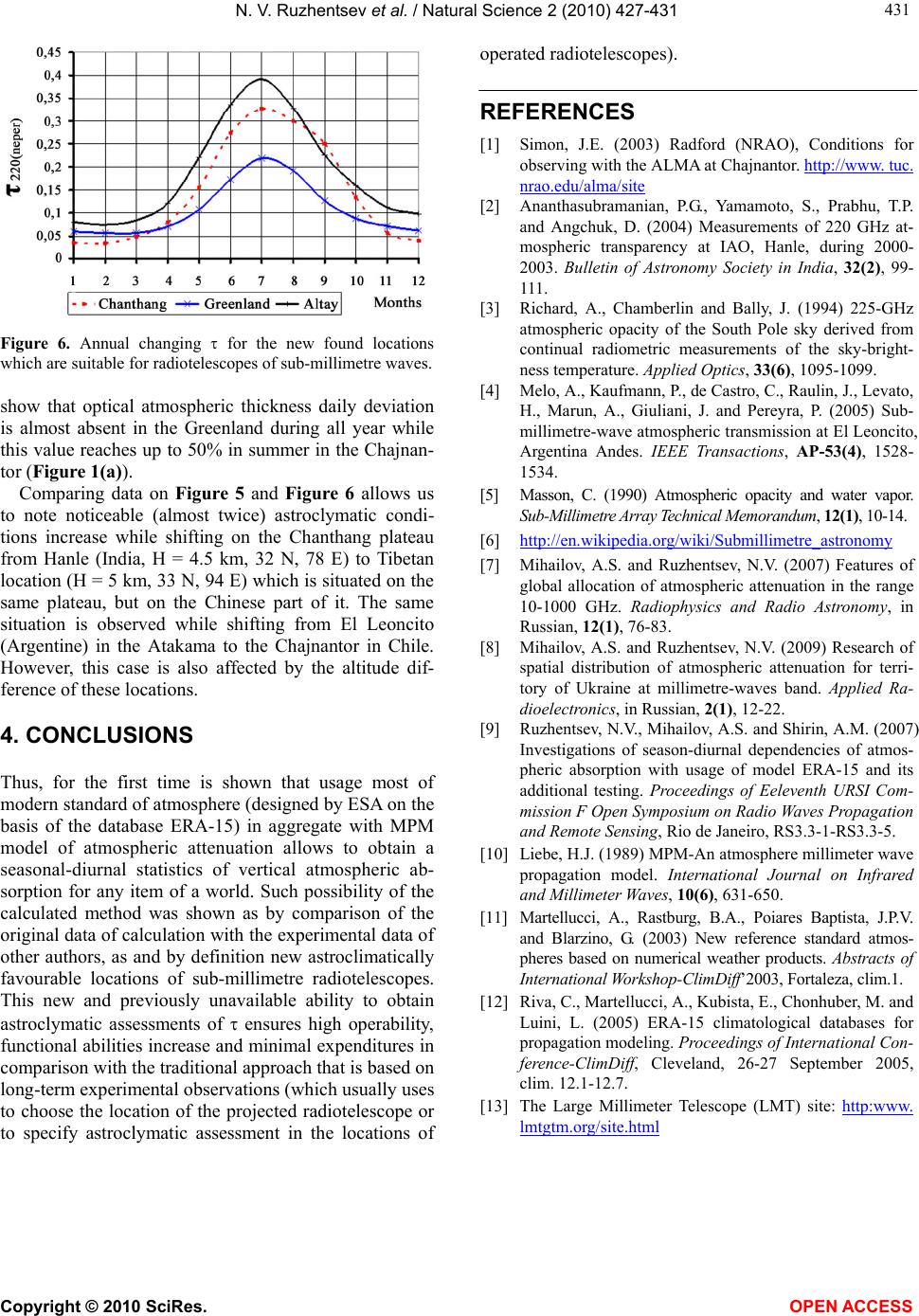
N. V. Ruzhentsev et al. / Natural Science 2 (2010) 427-431
Copyright © 2010 SciRes. OPEN ACCESS
431
431
Figure 6. Annual changing for the new found locations
which are suitable for radiotelescopes of sub-millimetre waves.
show that optical atmospheric thickness daily deviation
is almost absent in the Greenland during all year while
this value reaches up to 50% in summer in the Chajnan-
tor (Figure 1(a)).
Comparing data on Figure 5 and Figure 6 allows us
to note noticeable (almost twice) astroclymatic condi-
tions increase while shifting on the Chanthang plateau
from Hanle (India, H = 4.5 km, 32 N, 78 E) to Tibetan
location (H = 5 km, 33 N, 94 E) which is situated on the
same plateau, but on the Chinese part of it. The same
situation is observed while shifting from El Leoncito
(Argentine) in the Atakama to the Chajnantor in Chile.
However, this case is also affected by the altitude dif-
ference of these locations.
4. CONCLUSIONS
Thus, for the first time is shown that usage most of
modern standard of atmosphere (designed by ESA on the
basis of the database ERA-15) in aggregate with МРМ
model of atmospheric attenuation allows to obtain a
seasonal-diurnal statistics of vertical atmospheric ab-
sorption for any item of a world. Such possibility of the
calculated method was shown as by comparison of the
original data of calculation with the experimental data of
other authors, as and by definition new astroclimatically
favourable locations of sub-millimetre radiotelescopes.
This new and previously unavailable ability to obtain
astroclymatic assessments of ensures high operability,
functional abilities increase and minimal expenditures in
comparison with the traditional approach that is based on
long-term experimental observations (which usually uses
to choose the location of the projected radiotelescope or
to specify astroclymatic assessment in the locations of
operated radiotelescopes).
REFERENCES
[1] Simon, J.E. (2003) Radford (NRAO), Conditions for
observing with the ALMA at Chajnantor. http://www. tuc.
nrao.edu/alma/site
[2] Ananthasubramanian, P.G., Yamamoto, S., Prabhu, T.P.
and Angchuk, D. (2004) Measurements of 220 GHz at-
mospheric transparency at IAO, Hanle, during 2000-
2003. Bulletin of Astronomy Society in India, 32(2), 99-
111.
[3] Richard, A., Chamberlin and Bally, J. (1994) 225-GHz
atmospheric opacity of the South Pole sky derived from
continual radiometric measurements of the sky-bright-
ness temperature. Applied Optics, 33(6), 1095-1099.
[4] Melo, A., Kaufmann, P., de Castro, C., Raulin, J., Levato,
H., Marun, A., Giuliani, J. and Pereyra, P. (2005) Sub-
millimetre-wave atmospheric transmission at El Leoncito,
Argentina Andes. IEEE Transactions, AP-53(4), 1528-
1534.
[5] Masson, C. (1990) Atmospheric opacity and water vapor.
Sub-Millimetre Array Technical Memorandum, 12(1), 10-14.
[6] http://en.wikipedia.org/wiki/Submillimetre_astronomy
[7] Mihailov, A.S. and Ruzhentsev, N.V. (2007) Features of
global allocation of atmospheric attenuation in the range
10-1000 GHz. Radiophysics and Radio Astronomy, in
Russian, 12(1), 76-83.
[8] Mihailov, A.S. and Ruzhentsev, N.V. (2009) Research of
spatial distribution of atmospheric attenuation for terri-
tory of Ukraine at millimetre-waves band. Applied Ra-
dioelectronics, in Russian, 2(1), 12-22.
[9] Ruzhentsev, N.V., Mihailov, A.S. and Shirin, A.M. (2007)
Investigations of season-diurnal dependencies of atmos-
pheric absorption with usage of model ERA-15 and its
additional testing. Proceedings of Eeleventh URSI Com-
mission F Open Symposium on Radio Waves Propagation
and Remote Sensing, Rio de Janeiro, RS3.3-1-RS3.3-5.
[10] Liebe, H.J. (1989) MPM-An atmosphere millimeter wave
propagation model. International Journal on Infrared
and Millimeter Waves, 10(6), 631-650.
[11] Martellucci, A., Rastburg, B.A., Poiares Baptista, J.P.V.
and Blarzino, G. (2003) New reference standard atmos-
pheres based on numerical weather products. Abstracts of
International Workshop-ClimDiff’2003, Fortaleza, clim.1.
[12] Riva, C., Martellucci, A., Kubista, E., Chonhuber, M. and
Luini, L. (2005) ERA-15 climatological databases for
propagation modeling. Proceedings of International Con-
ference-ClimDiff, Cleveland, 26-27 September 2005,
clim. 12.1-12.7.
[13] The Large Millimeter Telescope (LMT) site: http:www.
lmtgtm.org/site.html